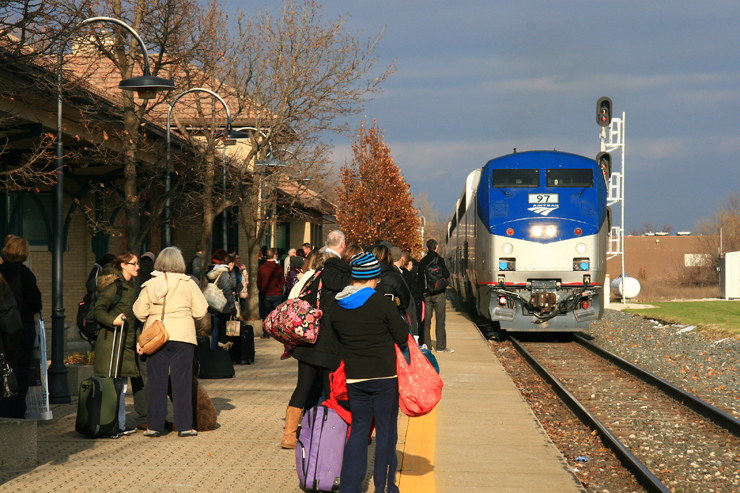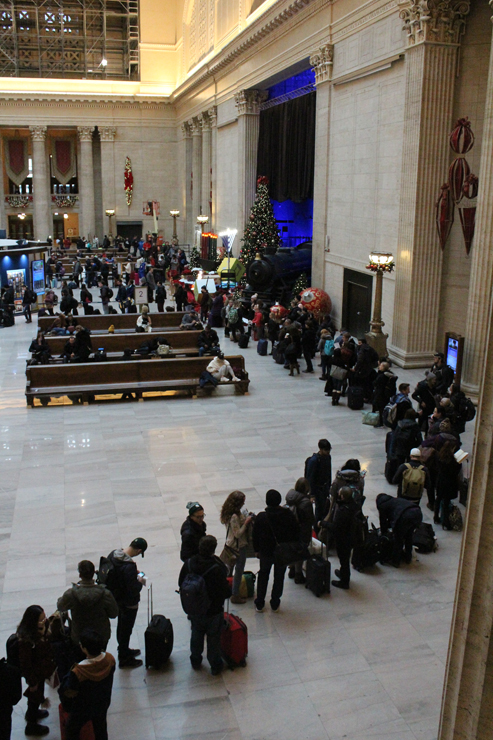On behalf of its state partners, Amtrak has petitioned host railroads Norfolk Southern, CSX, BNSF Railway, and Union Pacific to grant additional passenger train slots during a period when freight traffic is typically reduced. The hosts have always granted the holiday requests with the understanding that they were temporary and would not set a precedent for passenger trains at other times.
By manipulating schedules so some trains depart earlier and some later on the Wednesday before and Sunday after Thanksgiving, Amtrak was able to add midday round trips between Chicago and Holland, Mich., Bloomington-Normal, Ill., and Quincy, Ill., utilizing already-assigned equipment. That is happening again this year for the Illinois trains on Nov. 27 and Dec. 1.
In Michigan, however, the extra Holland turn on the Pere Marquette’s Chicago-Grand Rapids route and an additional round-trip between Chicago and Ann Arbor, Mich., that had filled morning eastbound and afternoon westbound departure voids on the normal schedules, won’t be running.
Amtrak spokesman Marc Magliari tells Trains News Wire that based on ridership data from last year, a decision was made to add cars to regularly scheduled Midwest trains rather than dedicate them to that extra frequency. Also, in recent years, demand has tended to spread out more evenly across more days than it had previously.
At least one additional coach will be added to the three Wolverine route consists from Wednesday, Nov. 27, through Sunday, Dec. 1, plus other trains before and after that window. One coach will also be added to two Lincoln Service Chicago-St. Louis round-trips, the Chicago-Carbondale Illini, and every Chicago-Quincy train.
Another factor weighing on the Michigan decision, including not running the extra round-trip to Holland, is Norfolk Southern’s recent poor passenger train handling between Chicago and Porter, Ind. In the quarter ending Sept. 30, Amtrak says freight train interference accounted for 58% of the 20,143 delay minutes incurred by all passenger trains. Train No. 352, the 1:20 p.m. Wolverine Chicago departure, accounted for almost a quarter of the delays in the six-train total.
“If we try to put additional trains on those tracks and delays occur, this could have a cascading effect delaying outbound trains because inbound equipment didn’t arrive on time,” Magliari says.















Gerald nailed it IMO. The Class 1s are still common-carriers, albeit freight-only today. If they want to ignore their statutory obligations on handling (what used to be noted by timetable) first-class Amtrak passenger trains they need to be reminded their common-carrier obligations re: passengers can certainly be restored by Congress if need be. They somehow managed to handle passenger trains well in the hundred-plus years prior to Railpax, yet also move their freight in a reliable fashion. Something tells me they’re better off with the Devil they know (Amtrak) than continuing to “poke the bear” (i.e. public) at their peril. Re-regulation is always a risk; no need to increase the likelihood it is implemented by an angered public and her representatives.
Mr. McFarlane,
You are correct, but-to paraphrase Mr. Reid’s comment, “The railroads, don’t care about that. Sorry, They just don’t, NO railroad, none, cares about that.”
A sidebar: seeing the line snaking thru CUS reminds one of the roomy concourse replaced by the cramped space in use today.
M Singer,
One problem with your suggestion, the railroads agreed to host the trains in order for the take over of passenger service by the Government agency to relinquish them from the losses…and they’re supposed to maintain the priority status from before.
When using the two California JPA’s as examples you also have to include the biggest factor…for LOSSAN they right if way is split between two agencies, BNSF doesn’t own the LA – SD corridor anymore, it’s split between Metrolink and San Diego’s Coaster services, so they control that line. For the Capitol corridor the state paid for double tracking but insisted that the UP prioritize and allow additional services, and I believe there’s an option to even purchase the right of way, since a lot of UP freights use the old WP Niles Canyon/Altamont pass line instead(I know almost all of the stack trains go that way).
All that needs to be done is to enforce the original agreement that the railroads agreed to, either that or insist they take the service back over and run them themselves at their cost. This isn’t rocket science, the passenger trains should be operating faster than the freights and therefore have priority and not be causing delays vs the other way around.
Interestingly, how many remember that how the Class 1 railroads kept their hand on the pulse of reservations thru the mid-1960s, by maintaining wait lists for parlors on their day trains. For the Midwest, this meant the GM&O, WAB, CB&Q, etc were able to add parlor cars to handle their higher revenue passengers.
Not only did the Class 1s increase their consists, even additional sections, to serve the public during the holidays, but look how the Class 1s rose to the occasion in summer 1966.
Though widely considered how this response of the railroads to the 1966 national airline strike, despite that being their “last hurrah,” the lines carried on. Who can forget the SAL’s declaration to keep their train consists limited to 18 cars to prevent over-burdening the dining cars?
The government, including Amtrak, don’t care about that. Sorry, They just don’t, NO govt agency, none , care about that.
Rather than Amtrak executives focused on creating templates to decapitate the long distance routes and spiking the PRIIA full cost allocation formula to increase costs to state-supported corridors, it behooves Amtrak to prioritize its actions.
This means, Amtrak should request the FRA to serve as an honest broker to bring together Amtrak and the Class 1s to create a new economic relationship. The time has long passed for Amtrak to cease hiding behind Congress by refusing to even acknowledge how economic valuations have changed since Railpax secured the initial discounted agreement in 1971.
Amtrak needs to learn how the market valuation of track access and prioritized dispatching has changed, as a result of mergers, traffic, and mainline reductions. If the FRA can achieve for both sides an appreciation of how OTP has economic value-and consequences, than ideally we can move forward by increasing frequencies and new routes. Certainly, we can learn from potential new traffic patterns through the holiday schedules.
The inevitable answer will be for the Class 1s and Amtrak working together, with the support of the FRA, to secure congressional and state funding to construct additional, dedicated mainline track for passenger rail to prevent interference with freight operations.
Despite acting as a federal monopoly, it is incumbent upon Amtrak to learn Econ 101a in how to deal with private business. Do note how California’s JPAs, LOSSAN and Capitol, learned long ago how to work with the Class 1s to secure governmental funding to improve infrastructure to facilitate increased and faster frequencies.
Curious if during this holiday travel season if the “short” coaches will be restored to select long distance trains?